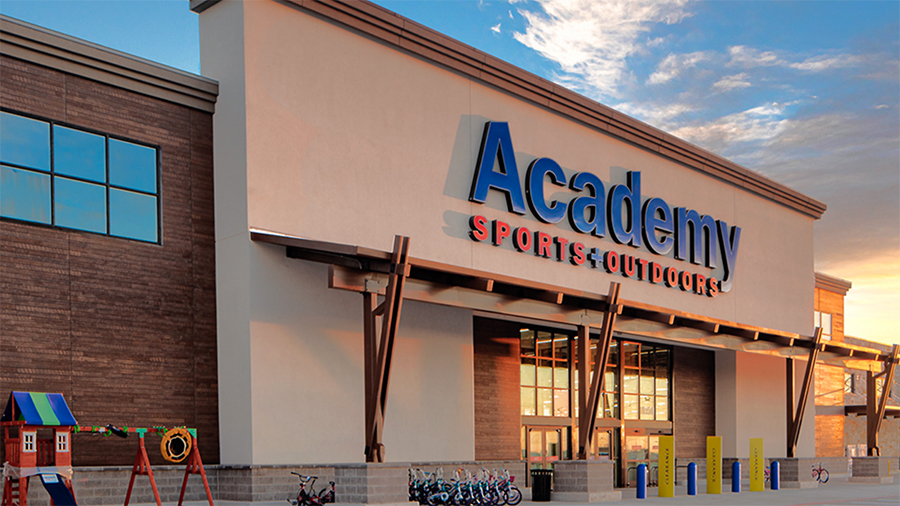At its Investor Day meeting, Academy Sports and Outdoors, Inc. outlined plans to open 120-to-140 new stores over the next five years through 2027, expanding its store base by 50 percent in existing and new markets. The Katy, TX-based retailer currently has 268 stores across 18 states.
During the meeting, Ken Hicks, chairman, president and CEO, said the retailer had returned to an aggressive growth mode after undergoing an extensive improvement program since becoming CEO in 2018, which helped accelerate growth over the last few years. The improvement program touched everything from assortments to the in-store experience, marketing, omnichannel capabilities, e-commerce, and supply chain.
An increased appeal during the pandemic for outdoor activities, at-home fitness, nesting, and leisure trends also aided Academy’s growth.
Sales have climbed 30 percent since 2019 through operational improvements and academy.com without adding new stores.
“We are a company positioned for growth through new store expansion, omni-channel advancements and continuing to improve our existing stores,” said Hicks. “We are one of the best opportunities in sustainable growth in retail today with a proven model that has been resilient through some of the most challenging times for retail. We’ve done that with a focus on our assortment, our value and the customer experiences that differentiate us from the competition and other retailers.”
Directly addressing the new store opportunity, Michael Mullican, EVP and CFO, said Academy is “primarily regional” with stores in the South and Southeast, leaving ample room to open locations. He said, “Only 17 percent of the U.S. population lives within ten miles of an Academy store compared to 60 percent for Dick’s. We’ve got a lot of blank space here.”
Academy will open in “the fastest growing states and markets in the country,” including Texas and Florida.
However, the primary financial reason Academy has ramped up expansion, according to Mullican, is because the business is generating significant cash, and store openings are generating a high return on invested capital (ROIC).
“Our stores are the most profitable and most productive in the sector,” said Mullican. “It’s not even close. We do $340 in sales per square foot compared to roughly $290 per square foot at our closest natural competitor. Our average store at maturity generates about $4 million dollars of four-wall EBIT a year. The worst stores, the lowest performers, generate roughly the same amount of profit as our competition’s average stores.”
Mullican further noted that store growth is “accretive to everything we do.” For instance, opening stores in new markets increases brand awareness to support sales on Academy.com. New stores will improve supply chain efficiencies, with two of Academy’s three distribution centers operating at 50 percent capacity or lower for two for a decade. He added that becoming more of a national player also helps vendor relations.
New stores produce around $18 million in sales, or $16 million excluding the omnichannel benefit, cost about $5 million to $6 million of net capital, take about four to five years before reaching maturity, deliver an ROIC exceeding 20 percent, and EBITDA positive in the first year.
He said Academy is also comfortable ramping up expansion despite a potential downturn. He described sporting goods as a “relatively durable sector,” with categories such as jewelry, furniture and non-athletic apparel likely feeling the impact of reduced spending on discretionary items before sporting goods.
Moreover, during the last recession, the sporting goods category was down 3.5 percent but Academy outperformed, with positive comps in 2008, 2009 and 2010. Mullican also said that Academy is “running a better business” versus the last recession. And due to the pandemic, Academy saw “millions of customers pick up new hobbies and interests, and they seem to be sticking with them.”
Finally, Mullican noted that sales in the sporting goods categories had outpaced personal consumption over the last two decades, and the overall industry had become “much healthier” in recent years to support expansion.
Said Mullican, “Our vendors are more rational. There’s less competition. I think our lane is more clearly defined than it was in the past. Our competition is also better, and I’ve said many times on our conference calls that retail is a business where other people’s problems can quickly become yours, particularly when inventory gets mismanaged. And I believe our competition as a whole is much better and much healthier, so that should support better margins and better performance going forward.”
Academy opened nine stores in 2022, marking its first new stores in three years, and plans to open 13-to-15 in 2023. All of Academy’s 2022 store openings will clear the 20 percent ROIC hurdle. Academy is taking a “test and learn” approach to new stores and plans to “gradually accelerate” store openings over a five-year growth plan. A fourth distribution facility is scheduled to open in late 2025 or 2026. Longer term, Academy sees the opportunity to open more than 800 stores.
“The next five years are just the beginning,” said Mullican. “This still leaves about half the United States where we can grow. And because our model is so profitable and productive, we don’t need a new format. We don’t need to try anything new or different. We just need to do more of what we’re doing. That’s the best strategy for us. We’re going to enter some very large metropolitan areas to achieve these growth plans. We’ll do that in scale. We won’t come in one or two at a time.”
Overall, Academy’s five-year growth plan calls for sales to expand from $6.4 billion in 2022 to $10 billion in 2027. The new store openings are expected to add between $2.4 billion to $2.8 billion in sales, omnichannel benefits are expected to add between $700 million and $900 million in sales and improving productivity from existing stores is expected to add $500 million to $700 million in sales. Online penetration is expected to expand to more than 15 percent of revenue from about 10 percent.
Comps are expected to be in the low-to-mid single digits, resulting in an overall 10 percent top-line compound annual growth rate (CAGR) over its five-year plan.
Gross margins are planned to land in the range of 34.0 percent to 34.5 percent each year over the five-year plan, which compares with 34.9 percent on an adjusted basis in 2022.
Merchandise margins are expected to improve 40 basis points primarily due to continuous process improvement, including better planning and allocation, better buying optimization or localization, enhanced clearance efforts, and upgraded labor scheduling.
Academy’s merchandise mix is also expected to benefit as higher-margin apparel and footwear categories grow faster than outdoor and sports & recreation categories. Private-label apparel expansion is also expected to improve gross margins. Private labels are expected to expand from about 21 percent to 25 percent of the total business.
Supply chain improvements are expected to benefit margins by 100 basis points due to its new warehouse management system and leveraging supply chain visibility to drive transportation efficiencies. These areas are expected to offset margin pressures from a new distribution center, e-commerce fulfillment, marketing/digital investments, new store expenses, and technology investments.
In his presentation, Hicks noted that Academy always had a “great bone structure” with many loyal customers in an appealing category.
“We have a deep consumer connection in our markets,” said Hicks. “If you talk to people in our markets and ask them about Academy, they usually say, ‘I love Academy,’ and that is because of what we offer them. And that’s fun with a great assortment, strong values and an experience that has given us that enduring loyalty for our consumers and within our communities.”
However, before the restructuring efforts were underway by Hicks and his team, Academy was not “very good at executing.” He noted that Academy, about six years ago, landed at the top of a list of retailers expected to go bankrupt.
“The reason we were in the position we were in is we were not strong operators,” said Hicks. “We weren’t focused on the customer. This still had a lot of roots in the family business, and it was about us. Although we had bought some new systems as KKR had invested a lot of money, we weren’t using them.”
Hicks said the company is focused on three pillars —assortment, value proposition and experience in-store and online—allowing the company to achieve the goals set under its last five-year plan established in 2018 within four years.
He noted that Academy had created $4 billion in market capitalization since going public in October 2020. Over that time, Academy had returned about $2 billion to shareholders, $900 million in share buybacks, a billion in debt reduction, and $25 million in dividends.
Hicks believes the last few years have “built that foundation” to now drive sales through expansion.
“We’ve been able to demonstrate that we have the capability to generate tremendous value,” said Hicks. “We’ll be able to deliver tremendous value going forward, a tremendous opportunity for our team and fun for a lot more people so everyone benefits.”
Photo courtesy Academy Sports
















